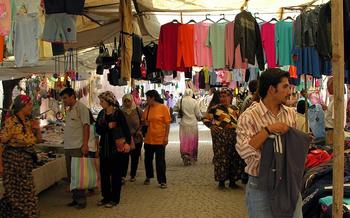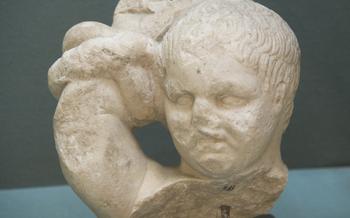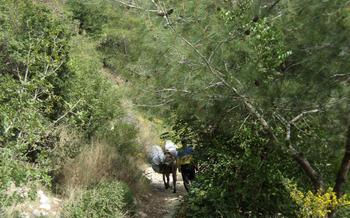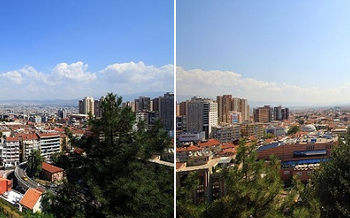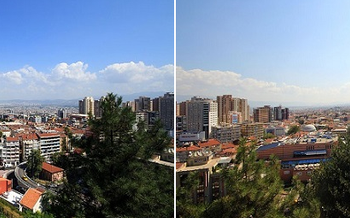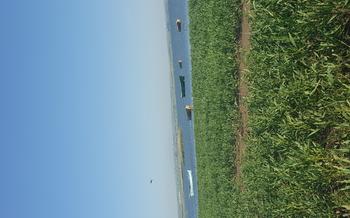
The Necropolis of Daskyleion
- A Journey to Daskyleion
- Peering into the Past: The History of Daskyleion
- Unraveling the Necropolis: The Enigmatic City of the Dead
- A Walk Through Time: Exploring the Necropolis
- The Tumulus of King Pharnaces: A Royal Legacy
- Other Notable Tombs: A Journey Through History
- Excavating the Past: Archaeological Discoveries at Daskyleion
- The Art of Ancient Daskyleion: A Visual Legacy
- A Haven for Nature and History: The Surrounding Landscape
- Local Customs and Traditions: A Cultural Tapestry
- The Necropolis of Daskyleion in Literature and Art: A Cultural Legacy
- Recommended Tours and Itineraries: A Comprehensive Guide for Travelers
- Accommodation and Dining Options: A Traveler's Guide
- Insider Tip: Hidden Gems and Off-the-Beaten-Path Experiences
A Journey to Daskyleion
Daskyleion, an ancient city of profound historical significance, lies in the heart of Turkey's Balıkesir province. Once a powerful regional center, Daskyleion's ruins stand as a testament to its glorious past. While much of the city remains shrouded in mystery, the Necropolis of Daskyleion offers a glimpse into the lives and customs of its ancient inhabitants.
Located just a short distance from the modern city of Balıkesir, Daskyleion's necropolis is easily accessible by road. Visitors can immerse themselves in the history of this ancient city, as they wander among the ruins and explore the tombs that dot the landscape. Join us as we embark on a journey to Daskyleion, unraveling the mysteries of its necropolis and discovering the secrets of this once-thriving metropolis.
Peering into the Past: The History of Daskyleion
Daskyleion's story begins in the mists of antiquity, its origins shrouded in the shadows of time. As the capital of ancient Bithynia, it emerged as a significant regional power during the 7th century BC, under the rule of the Phrygian dynasty. The city's strategic location at the crossroads of major trade routes transformed it into a thriving commercial hub, attracting merchants and traders from across the ancient world.
During the Persian era, Daskyleion served as the administrative center of the satrapy of Phrygia, a pivotal province within the vast Achaemenid Empire. Satrap Pharnaces, a powerful and influential figure, governed the region, leaving an enduring legacy that would shape the city's future.
The Hellenistic period witnessed a shift in power, as Alexander the Great's conquests brought Daskyleion under the sway of the Macedonian Empire. The city's strategic importance remained undiminished, and it continued to flourish as a center of trade and culture.
As the Roman Empire rose to prominence, Daskyleion's fortunes remained intertwined with the ebb and flow of imperial power. The city embraced Roman customs and traditions, becoming a vital part of the province of Bithynia et Pontus. Its prosperity continued unabated, as it served as a key administrative and economic center within the Roman domain.
The arrival of the Byzantine era marked a period of transition for Daskyleion. The city retained its significance, albeit under a different political and religious order. However, as the Byzantine Empire faced challenges from within and without, Daskyleion's decline mirrored the broader transformations taking place across the empire.
Today, the ruins of Daskyleion stand as a testament to its glorious past. The Necropolis of Daskyleion, with its enigmatic tombs and intricate funerary rituals, offers a glimpse into the lives and beliefs of the ancient inhabitants. As we explore this ancient city, we uncover the layers of history that have shaped its destiny, leaving behind a legacy that continues to captivate and inspire.
Unraveling the Necropolis: The Enigmatic City of the Dead
The necropolis of Daskyleion is a sprawling expanse of ancient tombs and burial structures that stretches beyond the city's walls. Its unique characteristics set it apart from other ancient burial grounds. One of the most striking features of the necropolis is its sheer size. It is one of the largest necropolises in Turkey, covering an area of over 100 hectares. This vast expanse is a testament to the city's wealth and power during its heyday.
The variety of tombs found within the necropolis is another remarkable aspect. There are tumuli, or burial mounds, of various sizes, some of which are believed to belong to important figures such as King Pharnaces. Sarcophagi, stone coffins often elaborately decorated, are also found in abundance. These sarcophagi offer valuable insights into the funerary customs and beliefs of the ancient inhabitants of Daskyleion. Some of the sarcophagi are adorned with intricate carvings and inscriptions, providing clues about the individuals buried within.
Exploring the funerary customs and rituals practiced by the ancient inhabitants is a fascinating aspect of visiting the necropolis. The tombs reveal a wealth of information about the beliefs and practices surrounding death and the afterlife. The tumuli, for example, were often constructed with multiple chambers and elaborate burial chambers, indicating the importance placed on the deceased's journey to the afterlife. The presence of grave goods, such as pottery, jewelry, and weapons, suggests the belief in a continuation of life after death.
A Walk Through Time: Exploring the Necropolis
The Necropolis of Daskyleion offers a captivating journey through the past, where visitors can immerse themselves in the grandeur of ancient burial customs and traditions. The main features of the necropolis include the tumulus of King Pharnaces, a monumental structure that stands as a testament to the power and influence of the Phrygian ruler. Other notable tombs within the site include rock-cut tombs, vaulted tombs, and chamber tombs, each with its own unique architectural features and stories to tell.
To fully appreciate the necropolis's significance, it is recommended to embark on a guided tour or hire a knowledgeable guide who can provide insights into the history, culture, and symbolism associated with the site. Visitors can wander through the sprawling expanse of the necropolis, discovering hidden corners and unraveling the secrets of the ancient city's inhabitants.
For those interested in exploring independently, there are several paths and trails that wind through the site, offering opportunities to stumble upon hidden gems and lesser-known tombs. It is important to wear comfortable shoes and be prepared for uneven terrain, as the necropolis is located on a hillside.
The necropolis is open to visitors daily, and there is a small entrance fee. Visitors should plan to spend at least two to three hours exploring the site to fully appreciate its beauty and historical significance.
The Tumulus of King Pharnaces: A Royal Legacy
The most prominent feature of the Necropolis of Daskyleion is the tumulus of King Pharnaces, a colossal mound that stands as a testament to the power and prestige of its royal occupant. Satrap Pharnaces, a powerful ruler of ancient Phrygia, was laid to rest within this imposing structure, which serves as a symbol of his legacy and the enduring influence of his reign.
The tumulus is a remarkable feat of ancient engineering, constructed with precision and scale that reflects the opulence and grandeur of the Phrygian kingdom. Its sheer size, measuring approximately 60 meters in diameter and 12 meters in height, commands attention and exudes an air of regal authority.
Excavations at the tumulus have uncovered a wealth of artifacts and treasures, providing valuable insights into the life and times of King Pharnaces and the customs of the Phrygian elite. Among the discoveries are exquisite gold jewelry, intricate pottery, and finely crafted weapons, all of which attest to the opulence and sophistication of the Phrygian court.
The tumulus of King Pharnaces stands as a poignant reminder of the grandeur of ancient Daskyleion and the enduring legacy of its rulers. As visitors marvel at its imposing presence, they are transported back in time, gaining a glimpse into the life and reign of a powerful monarch who left an indelible mark on the history of the region.
Other Notable Tombs: A Journey Through History
The Necropolis of Daskyleion boasts a rich array of tombs beyond the prominent tumulus of King Pharnaces. Embark on a journey through time as you explore the diverse range of burial structures that offer a glimpse into the lives and legacies of ancient Daskyleion's inhabitants.
Discover the intricate rock-cut tombs, carved directly into the natural rock formations, showcasing the skill and artistry of ancient craftsmen. These tombs often feature elaborate facades adorned with inscriptions and reliefs, providing valuable insights into the identity and status of the deceased.
Step into the vaulted tombs, with their impressive barrel-vaulted ceilings, demonstrating the architectural prowess of the ancient builders. These tombs often house multiple burial chambers, suggesting family or communal burial practices.
Explore the chamber tombs, characterized by their spacious interiors divided into multiple chambers. These tombs were often reserved for the elite and wealthy, featuring elaborate decorations and furnishings that reflect their elevated social status.
As you wander through the necropolis, uncover the stories behind the individuals buried within these tombs. Learn about their contributions to society, their beliefs and customs, and the social hierarchy that shaped ancient Daskyleion. Each tomb tells a unique tale, adding to the rich tapestry of the city's history.
Through these diverse burial structures, the Necropolis of Daskyleion offers a profound understanding of the cultural and social practices of ancient Daskyleion, providing a glimpse into the lives and legacies of its inhabitants.
Excavating the Past: Archaeological Discoveries at Daskyleion
Archaeological excavations at Daskyleion have played a pivotal role in unearthing the mysteries of this ancient city. Over the years, meticulous excavations have been conducted by teams of archaeologists, both Turkish and international, revealing a treasure trove of artifacts and shedding light on the city's rich history.
One of the most significant discoveries was the unearthing of a large number of tombs within the necropolis. These tombs, ranging from simple graves to elaborate mausoleums, have provided invaluable insights into the funerary customs and rituals practiced by the ancient inhabitants of Daskyleion. The tombs have yielded a wealth of artifacts, including jewelry, pottery, weapons, and personal belongings, offering glimpses into the lives and social status of the individuals buried there.
Among the most notable discoveries at Daskyleion is the monumental tumulus of King Pharnaces, which has been extensively excavated and restored. The tumulus, with its impressive size and architectural features, has provided valuable information about the power and influence of the Phrygian rulers. Excavations within the tumulus have revealed a wealth of artifacts, including gold jewelry, coins, and luxury items, reflecting the opulence and prestige of the Phrygian court.
The ongoing archaeological research at Daskyleion is not only focused on excavating tombs but also on uncovering the remains of the ancient city itself. Excavations have revealed the foundations of buildings, streets, and public spaces, providing a glimpse into the urban layout and daily life in Daskyleion. These discoveries have helped to reconstruct the city's history and understand its role as a regional center during antiquity.
The artifacts and findings unearthed at Daskyleion are carefully documented, analyzed, and preserved by archaeologists. Many of these artifacts are displayed in museums in Turkey, including the Balıkesir Museum of Archaeology and the İstanbul Archaeological Museums, where visitors can learn more about the fascinating history of this ancient city and its necropolis.
The Art of Ancient Daskyleion: A Visual Legacy
The Necropolis of Daskyleion is not only a treasure trove of historical knowledge but also a testament to the artistic prowess of its ancient inhabitants. Within the tombs, visitors can marvel at a diverse array of artistic expressions, including sculptures, mosaics, and reliefs that adorn the walls and chambers.
These artworks showcase a blend of Hellenistic and Roman influences, reflecting the cultural crossroads that Daskyleion once was. The sculptures, often depicting gods, goddesses, and mythological figures, exhibit a mastery of form and detail that is both captivating and awe-inspiring.
The intricate mosaics, depicting scenes from mythology, nature, and everyday life, add a vibrant touch to the otherwise somber environment of the tombs. These colorful compositions offer glimpses into the beliefs, values, and aspirations of the ancient people of Daskyleion.
The reliefs, carved into the stone walls of the tombs, narrate stories of battles, triumphs, and religious rituals. They provide valuable insights into the historical events and cultural practices of the ancient city.
By studying the art of the Necropolis of Daskyleion, visitors can gain a deeper understanding of the artistic traditions, cultural influences, and creative spirit of the ancient world.
A Haven for Nature and History: The Surrounding Landscape
Beyond the historical significance of the Necropolis of Daskyleion, the surrounding landscape offers a rich tapestry of natural beauty and ecological diversity. The region is characterized by rolling hills, lush forests, and tranquil waterways, creating a picturesque backdrop for exploration. Visitors can embark on scenic hikes through the verdant woodlands, discovering hidden trails and secluded viewpoints that offer breathtaking panoramas of the countryside.
The area is also a haven for birdwatchers, with a variety of avian species calling the forests and wetlands their home. Keen-eyed observers can spot migratory birds, such as storks and eagles, soaring gracefully overhead, while the melodious songs of nightingales fill the air at dusk.
In addition to its natural beauty, the surrounding landscape holds significant historical and cultural value. Ancient ruins, such as abandoned villages and fortifications, can be found scattered throughout the region, offering glimpses into the past and the diverse civilizations that have inhabited this land.
Exploring the surroundings of the Necropolis of Daskyleion provides a holistic experience that combines history, nature, and cultural discovery. Whether you're an avid hiker, a passionate birdwatcher, or simply seeking tranquility amidst natural beauty, the region offers a wealth of opportunities to create lasting memories.
Local Customs and Traditions: A Cultural Tapestry
The region surrounding the Necropolis of Daskyleion is steeped in a rich tapestry of local customs and traditions that have been passed down through generations. These traditions reflect the diverse cultural influences that have shaped the region over centuries, blending ancient Anatolian customs with Greek, Persian, and Islamic influences.
One of the most prominent local traditions is the art of carpet weaving. The region is renowned for its exquisite hand-woven carpets, which are often adorned with intricate designs and vibrant colors. Visitors can witness the skill of local artisans as they create these beautiful works of art using traditional looms and techniques.
Gastronomy plays a vital role in the local culture, with a cuisine that showcases the region's fresh produce and flavorful ingredients. Traditional dishes include grilled meats, savory stews, and an abundance of fresh vegetables and herbs. Visitors can indulge in culinary delights at local restaurants or immerse themselves in the local culture by participating in cooking classes or visiting traditional markets.
Social interactions and hospitality are highly valued in the region. Locals are known for their warm and welcoming nature, often inviting visitors to share meals, stories, and experiences. Attending local festivals and celebrations is a fantastic way to immerse oneself in the vibrant local culture and witness traditional performances, music, and dances.
Respect for elders and community members is a cornerstone of local tradition. Visitors are encouraged to greet elders with a warm handshake or a slight bow as a sign of respect. Understanding local customs and traditions, such as removing shoes before entering a home or mosque, is essential for showing respect and fostering a positive interaction with the local community.
The Necropolis of Daskyleion in Literature and Art: A Cultural Legacy
The Necropolis of Daskyleion has captured the imagination of artists, writers, and filmmakers throughout history, leaving an enduring mark on the cultural landscape. In literature, the necropolis has served as a backdrop for historical novels, tales of adventure, and even supernatural thrillers. Authors have drawn inspiration from the site's enigmatic atmosphere, weaving stories that blend fact and fiction to create compelling narratives.
In the realm of visual arts, the necropolis has been immortalized in paintings, sculptures, and photographs. Artists have been drawn to the site's unique visual appeal, capturing its haunting beauty and evocative atmosphere on canvas and in stone. The necropolis has also been featured in films and documentaries, bringing its history and cultural significance to a wider audience.
One notable example is the 2018 Turkish film "Daskyleion'un Sırrı" (The Secret of Daskyleion), which explores the mysteries surrounding the necropolis and the ancient city it once served. The film blends historical elements with fictional storytelling, creating a thrilling narrative that captivates viewers.
These artistic interpretations of the Necropolis of Daskyleion not only showcase the site's cultural significance but also contribute to its enduring legacy. They provide a unique lens through which to view the necropolis, inviting audiences to explore its history, culture, and mythology in new and imaginative ways.
Recommended Tours and Itineraries: A Comprehensive Guide for Travelers
To enhance your experience at the Necropolis of Daskyleion, various guided tours and itineraries are available to cater to diverse interests and preferences. Here's a comprehensive guide to help you plan your visit:
- Guided Tours:
- Embark on a guided tour led by knowledgeable local experts who will share insights into the history, architecture, and significance of the necropolis.
-
These tours often include transportation to and from the site, allowing you to relax and focus on the wonders of Daskyleion.
-
Self-Guided Tours:
- For those who prefer to explore at their own pace, self-guided tours are a great option.
-
Purchase a detailed map or guidebook to navigate the site independently, allowing you to linger longer at specific points of interest.
-
Day Trips from Nearby Cities:
- If you're short on time, consider a day trip to the Necropolis of Daskyleion from nearby cities like Bandirma or Bursa.
-
These day trips typically include transportation, guided tours, and visits to other nearby attractions, making the most of your time.
-
Multi-Day Itineraries:
- For a more immersive experience, consider a multi-day itinerary that combines a visit to the necropolis with other historical and natural attractions in the region.
-
Explore ancient ruins, hike through stunning landscapes, and immerse yourself in the local culture.
-
Customizable Itineraries:
- To tailor your experience, work with local tour operators to create a customized itinerary that aligns with your interests and budget.
- Whether you're interested in history, archaeology, nature, or a combination of all three, a customized itinerary ensures a truly personalized journey.
Remember to plan your visit during the shoulder seasons (spring and autumn) to avoid the summer crowds and enjoy pleasant weather conditions.
Accommodation and Dining Options: A Traveler's Guide
When planning your visit to the Necropolis of Daskyleion, a range of accommodation options awaits you, catering to diverse preferences and budgets. For a truly immersive experience, consider staying in one of the charming guesthouses or boutique hotels in the nearby town of Erdek. These accommodations often exude a distinct local character, allowing you to soak in the region's atmosphere.
For a more luxurious stay, opt for one of the resorts along the scenic coastline, offering breathtaking views of the Marmara Sea. These resorts provide a haven of tranquility, with amenities such as private beaches, swimming pools, and spa facilities.
When it comes to dining, savor the delectable flavors of Turkish cuisine at local restaurants in Erdek or the surrounding villages. Indulge in traditional dishes prepared with fresh, seasonal ingredients, tantalizing your taste buds with culinary delights. Don't miss the opportunity to try freshly caught seafood, a specialty of the region.
Whether you seek budget-friendly options or a touch of luxury, the area around the Necropolis of Daskyleion offers a range of accommodations and dining experiences to suit every traveler's needs. Embrace the local culture, interact with the friendly locals, and create lasting memories as you explore this captivating historical site.
Insider Tip: Hidden Gems and Off-the-Beaten-Path Experiences
Beyond the main attractions of the Necropolis of Daskyleion, there are hidden gems and off-the-beaten-path experiences waiting to be discovered by curious travelers. For those seeking a deeper connection with the site's history and cultural significance, here are a few insider tips:
-
Explore the Hidden Trails: Venture off the main paths and discover a network of lesser-known trails that wind through the necropolis. These trails offer a chance to explore the site at your own pace, stumble upon hidden tombs, and immerse yourself in the tranquility of the natural surroundings.
-
Seek Out Secluded Viewpoints: Take the time to find secluded viewpoints that offer breathtaking panoramas of the necropolis and the surrounding landscape. These viewpoints provide a unique perspective on the site's layout and allow you to appreciate its grandeur from a different angle.
-
Discover Lesser-Visited Tombs: While the tumulus of King Pharnaces is a must-see, there are many other tombs within the necropolis that are equally fascinating but receive fewer visitors. Seek out these lesser-visited tombs to gain a deeper understanding of the diverse burial practices and social hierarchy of ancient Daskyleion.
-
Uncover Unique Experiences: For a truly unique experience, consider visiting the necropolis at sunrise or sunset. The warm glow of the rising or setting sun casts a magical light on the ancient ruins, creating a breathtaking atmosphere that enhances the site's mystique.
-
Engage with Local Experts: To delve deeper into the history and significance of the Necropolis of Daskyleion, consider engaging with local experts, such as historians, archaeologists, or tour guides. They can provide valuable insights, share untold stories, and help you uncover the hidden secrets of this ancient city of the dead.

